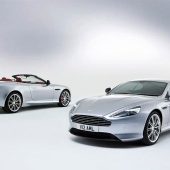Lexus updated its smallest, the IS-model range for the 2011. With improved powertrains, little changes to the exterior styling and refreshed interior design, the IS Lexus is trying to compete in the tough class of small, luxury sedans. According to Lexus, the new design elements reflect a further development of Lexus’ L-finesse design philosophy, giving the IS a more distinctive look and character and hallmarking it as a uniquely elegant, muscular and dynamic sports sedan. Sounds great and from the outside the new IS surely looks stylish and sporty, but for me it looks pretty much the same as before.
Quick check of the press material reveals that the front of the 2011 IS has been extensively restyled with a new, more deeply recessed front grille and reshaped vertical grille bars. The grille frame incorporates a more powerful interpretation of the trademark, Lexus L-finesse ‘arrowhead’ motif. This motif is also strongly represented in a revised, more aggressive, dark smoke coated headlamp design. Within a reshaped front bumper, the lower grille has also been restyled to optimise brake cooling airflow and emphasise the car’s low centre of gravity. From the rear, the 2011 model range can br recognised by a revised tail lamp cluster incorporating a new, pink smoked turn signal lens and back-up lens. The 2011 IS model range will be available in a choice of eleven colours, of which three, Ultrasonic Blue Mica, Midnight Blue and Starlight Black are newly available. Although this white seems to be working quite well also.
In Europe Lexus IS range offers three engine choices. The 2.2 litre aluminium block, commonrail turbodiesel in 220d offers 177 hp and has improved its fuel economy, which is now 5,5 litres /100km. If you desire for even better fuel economy and lower emissions, the 2.2 litre diesel is now available also as 150 hp version in 200d with average fuel consumption of 5,1 litres / 100km. We tested the only petrol version, the IS 250. Well there still is the V8 in the IS F, if you want even more power, but for basic IS-line this is the only petrol choice in Europe. The 2.5 litre V6 petrol engine combines D-4 direct injection technology with an electrically activated, 2-stage Acoustic Control Induction System (ACIS) and Dual VVT-i (Variable Valve Timing-intelligent). As a result, it develops 153 kW / 208 hp and maximum torque of 252 Nm. The acceleration from zero to hundred takes 8.5 seconds in summer conditions and the top speed is 225km/h.
208 horsepower doesn’t really match the sporty looks of the IS, but with 6-speed automatic transmission, it works quite well as a daily driver. As the roads were pretty slippery, we didn’t get the change to try all the power the engine has to give. The car was equipped with studless winter tyres, which are quiet and provide comfort ride, but felt quite slippery when accelerating. It was easy to get IS to loose its grip, but the traction control stopped us playing for more. Apparently the traction control doesn’t want go off completely even if you would like it to. The steering feels light, but surprisingly accurate even with winter tyres, so driving is quite a joy. The chassis seems to working well also, so it would have been nice to try longer slides because the the car felt easy to control.
IS 250 is only available with 6-speed automatic transmission. The 6-speed Super ECT’ electronically controlled automatic transmission with Artificial Intelligence (AI-)SHIFT Control has been improved through the addition of Road Condition Response Control. The system monitors throttle opening and vehicle speed to establish the presence of an incline or decline. On inclines the system prevents unnecessary upshifts to ensure adequate drive power is available. On declines, the system automatically downshifts to offer adequate engine braking. With automatic transmission the shifts are smooth and accurate. This is the way the automatic should work. You don’t really notice the gear changes at all. There is a possibility to change gears yourself, but you seldomly will.
The updated Lexus IS is very quiet and rides softly even in winter conditions, so the luxurious feel is definitely there. The 2.5-litre V6 is a good choice for daily driving, but with a rear-wheel drive and a nicely working transmission, we could handle even more power. IS looks great from the outside and inside the car there is a quality feeling, although some minor details remind us that it is related to Toyota. But if you haven’t driven a Toyota before, you won’t even notice them.
Specification
Engine
- Petrol
- 6-cylinder
- 2500cc
Power
- 153 kW (208 hp) / 6400rpm
Torque
- 252 Nm / 4800rpm
Transmission
- 6-speed automatic
- RWD
0-100km/h / 0-62mph
- 8.5 seconds
Top speed
- 225 km/h
Fuel consumption
- 8.4 l/100km
CO2 emissions
- 194 g/km










